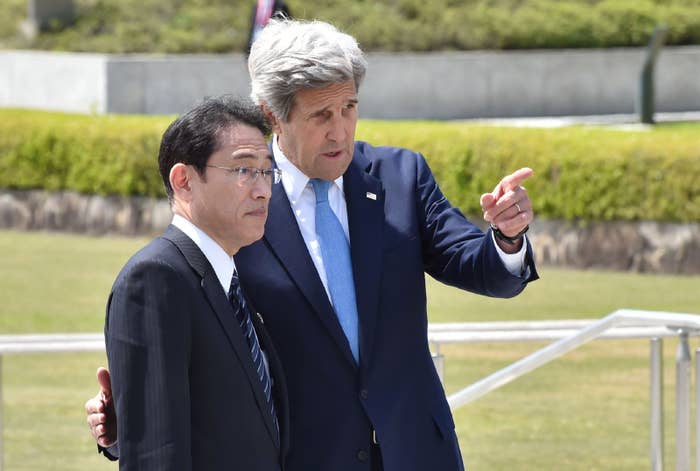
U.S. Secretary of State John Kerry did not apologize for America’s decision to drop an atomic bomb on Hiroshima during a historic visit to the memorial in the Japanese city.
He is the highest-ranking U.S. official ever to visit the memorial, which commemorates the 140,000 people who died in the world's first atomic bombing, which was carried out by an American plane on the city in August 1945.
Kerry visited the Bomb Dome — over which the A-bomb exploded — with the British Foreign Secretary Philip Hammond and other Group of Seven (G7) foreign ministers ahead of the global finance summit in Japan next month.
He did not speak publicly at the ceremony on Monday, but laid wreaths and spoke to a number of Japanese schoolchildren at the site.
Throughout the service, Kerry was seen whispering to the Japanese foreign minister Fumio Kishido — a Hiroshima native — and later penned a message in the visitors’ book.

“Everyone in the world should see and feel the power of this memorial,” Kerry wrote. “It is a stark, harsh, compelling reminder not only of our obligation to end the threat of nuclear weapons, but to rededicate all our effort to avoid war itself.”
"War must be the last resort — never the first choice," he added. "This memorial compels us all to redouble our efforts to change the world, to find peace and build the future so yearned for by citizens everywhere."
Ahead of the ceremony, an anonymous state department official reportedly told the Washington Post: “If you’re asking whether the secretary of state came to Hiroshima to apologize, the answer is no. If you’re asking whether the secretary and I think all Americans and all Japanese are filled with sorrow at the tragedies that befell so many of our countrymen, the answer is yes.”
Kerry is the first U.S. secretary of state to visit the memorial, and he later went to the nearby dedicated museum and engaged with some of the 900 schoolchildren present at the ceremony.
Hiroshima had previously been studiously avoided by visiting U.S. statesmen.
Speaking prior to the trip, Kerry had stressed his visit was focused on the “present and the future” although he also had said his time in Hiroshima would “revisit the past and honor those who perished”.
It comes ahead of President Barack Obama’s visit to Japan to attend the G7 summit next month. The White House has refused to comment on whether Obama will take the unprecedented step of visiting the memorial, becoming the first sitting U.S. president to do so, but an official suggested to Reuters there was no “great or insurmountable angst about the optics or the politics of a visit to Hiroshima”.
At least 140,000 people died after US B-29 bomber Enola Gay dropped a uranium bomb above the city, shortly after 8 a.m. on Aug. 6, 1945. A second bomb, dropped on Nagasaki three days afterwards, forced Japan to surrender and initiated the end of World War II.
Keiko Ogura, who was 8 years old when the bomb’s blast struck her home about 1.5 miles from the epicenter, recalled the “agonies of death” she witnessed. Now a campaigner for nuclear disarmament, Ogura called on each G7 minister to consider the tragedy of Hiroshima “as an individual”.

